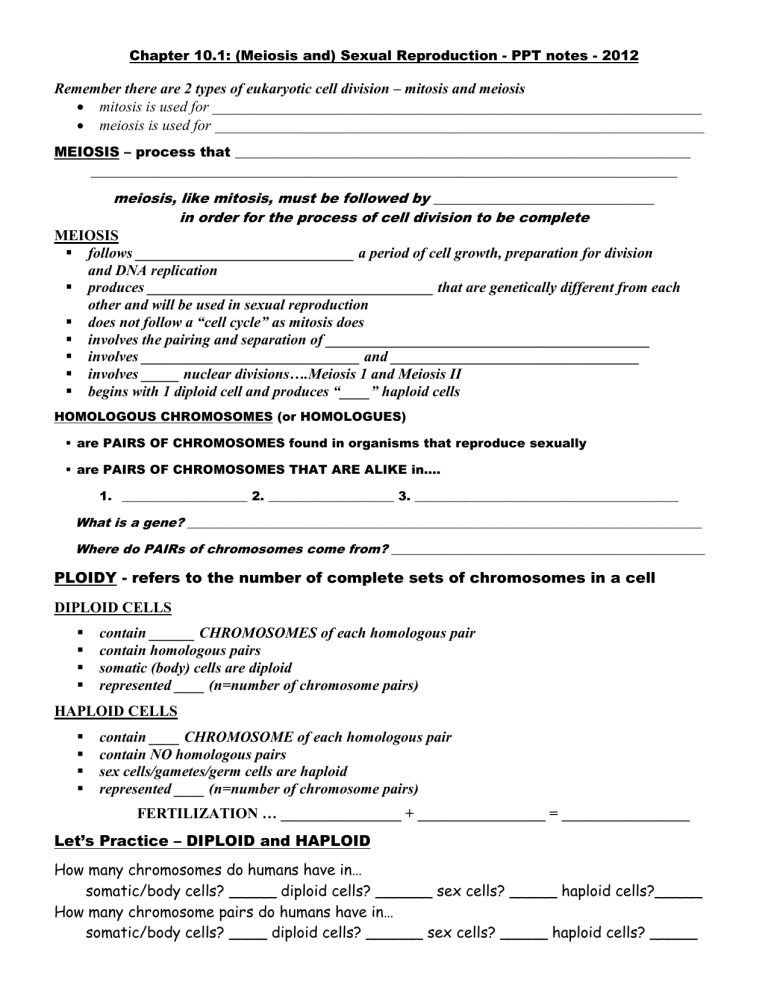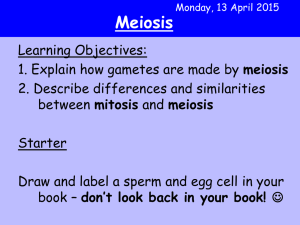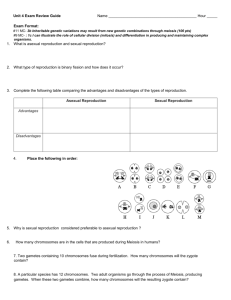MEIOSIS - a type of cell division that reduces the amount of genetic

Chapter 10.1: (Meiosis and) Sexual Reproduction - PPT notes - 2012
Remember there are 2 types of eukaryotic cell division – mitosis and meiosis
mitosis is used for _________________________________________________________________
meiosis is used for _________________________________________________________________
MEIOSIS – process that __________________________________________________________________
_____________________________________________________________________________________ meiosis, like mitosis, must be followed by ________________________________ in order for the process of cell division to be complete
MEIOSIS
follows _____________________________ a period of cell growth, preparation for division and DNA replication
produces ______________________________________ that are genetically different from each other and will be used in sexual reproduction
does not follow a “cell cycle” as mitosis does
involves the pairing and separation of ___________________________________________
involves _____________________________ and _________________________________
involves _____ nuclear divisions….Meiosis 1 and Meiosis II
begins with 1 diploid cell and produces “____” haploid cells
HOMOLOGOUS CHROMOSOMES (or HOMOLOGUES)
are PAIRS OF CHROMOSOMES found in organisms that reproduce sexually
are PAIRS OF CHROMOSOMES THAT ARE ALIKE in….
1.
____________________ 2. ____________________ 3. __________________________________________
What is a gene? __________________________________________________________________________________
Where do PAIRs of chromosomes come from? __________________________________________________
PLOIDY - refers to the number of complete sets of chromosomes in a cell
DIPLOID CELLS
contain ______ CHROMOSOMES of each homologous pair
contain homologous pairs
somatic (body) cells are diploid
represented ____ (n=number of chromosome pairs)
HAPLOID CELLS
contain ____ CHROMOSOME of each homologous pair
contain NO homologous pairs
sex cells/gametes/germ cells are haploid
represented ____ (n=number of chromosome pairs)
FERTILIZATION … ________________ + _________________ = _________________
Let’s Practice – DIPLOID and HAPLOID
How many chromosomes do humans have in…
somatic/body cells? _____ diploid cells? ______ sex cells? _____ haploid cells?_____
How many chromosome pairs do humans have in…
somatic/body cells? ____ diploid cells? ______ sex cells? _____ haploid cells? _____
MEIOSIS I and MEIOSIS II
MEIOSIS I - first nuclear division
involves the pairing and division of homologous chromosomes + produces ______ haploid cells
4 stages (followed by cytokinesis) - _________________________________________________
MEIOSIS II –second nuclear division
involves the division of the double-stranded chromosomes + produces ______ haploid cells
4 stages (followed by cytokinesis) - _________________________________________________
MEIOSIS I - the first nuclear division
PROPHASE I
________________________________________________________________________________
________________________________________________________________________________
synapsis ______________________________________________________________________
crossing over _________________________________________________________________
METAPHASE I
________________________________________________________________________________
ANAPHASE I
________________________________________________________________________________
TELOPHASE I
________________________________________________________________________________
________________________________________________________________________________
CYTOKINESIS
________________________________________________________________________________
MEIOSIS II - the second nuclear division (occurs simultaneously in 2 cells)
PROPHASE II
________________________________________________________________________________
________________________________________________________________________________
METAPHASE II
________________________________________________________________________________
ANAPHASE II
________________________________________________________________________________
TELOPHASE II
________________________________________________________________________________
________________________________________________________________________________
CYTOKINESIS
________________________________________________________________________________
MEIOSIS DIFFERS IN MALES and FEMALES
MEIOSIS in males is called _________________________________
MALE gametes are called ___________________________________
are formed in the ______________________
produce _____ haploid cells from 1 diploid cell
MEIOSIS in females is called ____________________________
FEMALE gametes are called ____________________________
are formed in the ____________________
produce ____ haploid cells and 3 _______________________ from 1 diploid cell
Are there other differences in the process of meiosis in males and females? Why?
ASEXUAL and SEXUAL REPRODUCTION
Asexual Reproduction Sexual Reproduction
In SEXUAL REPRODUCTION 2 haploid gametes (produced by meiosis) fuse in a process called FERTILIZATION and form a diploid cell called a ZYGOTE
GENETIC RECOMBINATION
OCCURS DURING CROSSING OVER IN __________________________ OF MEIOSIS
allows for variety among organisms
*THE MORE VARIETY WITHIN A SPECIES THE MORE LIKELY THAT SPECIES WILL SURVIVE*








